
Let's get the obvious out of the way: JamesBondJamesBondJamesBond. Sir Ian Flemming's infamous spy did drink a sort of martini. But it's not the sort we are going to talk about today. The Martini is the Little Black Dress of the cocktail world: simple, chic and effortless. When well constructed, it can make you feel like a million bucks.
For such a well known beverage, the origin is fuzzy. One story reaches back to the late 1800's in cosmopolitan San Francisco; the Martinez cocktail, served at the Occidental Hotel, may be the grandfather of this drink. Another story suggests the cocktail was named after a bartender at the Knickerbocker Hotel in New York City, circa 1911. And there's also the possibility that it was simply named after Martini brand Vermouth, which is an ingredient. Nothing too flashy, which seems awfully fitting for this drink.
The drink has, of course, evolved over time. Originally the Martinez consisted of sweet vermouth, sweet gin, maraschino, and bitters; it was served shaken and with a twist of lemon. By the end of the 19th century, the drink was streamlined and consisted of only orange bitters, French vermouth and English gin - stirred and served with an olive.
Ironically, the event that made this drink so popular was Prohibition. Gin was relatively easy to manufacture (illegally). It wasn't until the late 70's - early 80's that the drink fell out of fashion. By then, the Martini was seen as "old fashioned" and was passed over in favor of intricate cocktails or spritzers. The explosion of "-tini" drinks during the mid - 90's helped usher the Martini back into the spotlight. But make no mistake, just because "-tini" is at the end of a cocktail, doesn't mean it has anything to do with a classic Martini. It's usually tacked on because those drinks are often served in cocktail glasses, the traditional vessel of the Martini. Also, they can be kinda gross.
Classic Martini
(recipe by Equire.com)
1 ounce dry Vermouth
4 ounces gin
"Fill a metal shaker with cracked ice. Pour in the dry Vermouth, stir briefly, and strain out (this may be discarded). Add 4 ounces gin. Stir briskly for about 10 seconds, strain into a chilled cocktail glass, and garnish with an olive."
It's simple! The important thing is to have the best ingredients. At the risk of sounding a little too Ina Garten, you want "good" Vermouth and gin. Esquire suggests Noilly Prat Vermouth (and I agree) and Tanqueray, Bombay Sapphire, or Beefeater gin (I like all of those but Beefeater has been my favorite for a little while now). Try these out and do some of your own taste testing - it's important that you find something that you like.
Normally I talk about variations right about here and I was wrestling with the idea of leaving it be. The Martini is a classic and should be treated as such. But there are a few that Esquire recommends, and I trust those guys. So, we have the Third Degree which has a couple drops of Absinthe in it (I could think of worse ways to chase the Green Fairy) and a cocktail onion for garnish. There's also the Hoffman House; sub Plymouth gin (it's a specific kind of gin, not just a brand) and add a few dashes of orange bittters. And the Hearst, which uses Italian vermouth.
There's one more, which I will get to in the next installment. But for now, go forth and drink!






















